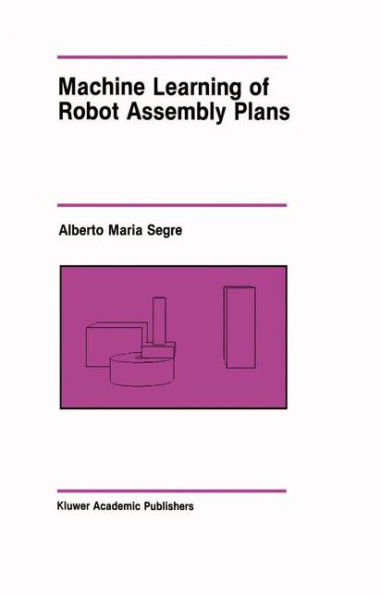5
1


Hardcover(1988)
$109.99
-
PICK UP IN STORECheck Availability at Nearby Stores
Available within 2 business hours
Related collections and offers
109.99
In Stock
Overview
The study of artificial intelligence (AI) is indeed a strange pursuit. Unlike most other disciplines, few AI researchers even agree on a mutually acceptable definition of their chosen field of study. Some see AI as a sub field of computer science, others see AI as a computationally oriented branch of psychology or linguistics, while still others see it as a bag of tricks to be applied to an entire spectrum of diverse domains. This lack of unified purpose among the AI community makes this a very exciting time for AI research: new and diverse projects are springing up literally every day. As one might imagine, however, this diversity also leads to genuine difficulties in assessing the significance and validity of AI research. These difficulties are an indication that AI has not yet matured as a science: it is still at the point where people are attempting to lay down (hopefully sound) foundations. Ritchie and Hanna [1] posit the following categorization as an aid in assessing the validity of an AI research endeavor: (1) The project could introduce, in outline, a novel (or partly novel) idea or set of ideas. (2) The project could elaborate the details of some approach. Starting with the kind of idea in (1), the research could criticize it or fill in further details (3) The project could be an AI experiment, where a theory as in (1) and (2) is applied to some domain. Such experiments are usually computer programs that implement a particular theory.

Product Details
| ISBN-13: | 9780898382693 |
|---|---|
| Publisher: | Springer US |
| Publication date: | 04/30/1988 |
| Series: | The Springer International Series in Engineering and Computer Science , #51 |
| Edition description: | 1988 |
| Pages: | 234 |
| Product dimensions: | 6.10(w) x 9.25(h) x 0.36(d) |
Table of Contents
1 Introduction.- 1.1. Machine Learning.- 1.2. Robotics.- 1.3. About the Book.- 2 Scenario.- 2.1. Preliminaries.- 2.2. Specifying the Problem.- 2.3. Attempting to Solve the Problem.- 2.4. Observing the Expert’s Plan.- 2.5. Generalizing the Solution.- 2.6. Solving the Same Problem After Learning.- 2.7. Solving Similar Problems After Learning.- 3 Explanation-Based Learning.- 3.1. Similarity-Based Learning.- 3.2. Learning-Apprentice Systems.- 3.3. Explanation-Based Learning.- 3.4. A Prototypical EBL System.- 3.5. Issues for EBL Systems.- 4 The Arms World.- 4.1. Characterizing the Robot World.- 4.2. Simulating the Robot World.- 5 Learning And Problem Solving.- 5.1. Knowledge Representation.- 5.2. The Performance Element.- 5.3. The Learning Element.- 6 The Arms Implementation.- 6.1. A Note About the Implementation Language.- 6.2. Optimization Tools.- 6.3. Implementing the Solid Modeler.- 6.4. Implementing the Graphics Subsystem.- 6.5. Implementing the Schema System.- 6.6. Implementing the Top Level.- 7 Scenario Revisited.- 7.1. Attempting to Solve the Problem.- 7.2. Observing the Expert’s Plan.- 7.3. Verifying the Solution.- 7.4. Generalizing the Solution.- 7.5. Solving the Same Problem After Learning.- 7.6. Solving Similar Problems After Learning.- 7.7. Observing Similar Problems After Learning.- 8 Summary And Future Work.- 8.1. Relation to Other Work.- 8.2. Extensibility of ARMS.- 8.3. Future Research Directions.- 8.4. Conclusions.- Appendix A Solid Modeling Systems.- Appendix B Schema Semantics.- Appendix C A Simpler Example.- C.1. Describing the Initial State.- C.2. Attempting to Solve the Problem.- C.3. Observing the Expert’s Plan.- C.4. Verifying the Solution.- C.5. Generalizing the Solution.- C.6. Solving the Same Problem After Learning.- C.7. Solving SimilarProblems After Learning.- C.8. Observing Similar Problems After Learning.- Appendix D A More Complex Example.- D.1. Describing the Initial State.- D.2. Attempting to Solve the Problem.- D.3. Observing the Expert’s Plan.- D.4. Verifying the Solution.- D.5. Generalizing the Solution.- D.5.1. A More General New Schema.- D.5.2. A More Operational New Schema.- D.6. Solving the Same Problem After Learning.- D.7. Solving Similar Problems After Learning.- Appendix E Performance Considerations.- E.1. Learning Episode 1.- E.2. Problem-Solving Episode 1.- E.3. Problem-Solving Episode 2.- E.4. Problem-Solving Episode 3.- E.5. Problem-Solving Episode 4.- E.6. Learning Episode 2.- E.7. Learning Episode 3.- E.8. Problem-Solving Episode 5.- E.9. Problem-Solving Episode 6.- Appendix F Built-in Schemata.- F.1. State Schemata.- F.1.1. Joint Schemata.- F.1.2. Degree of Freedom Schemata.- F.1.3. Constraint Schemata.- F.2. Operator Schemata.- F.2.1. Primitive Operator Schemata.- References.From the B&N Reads Blog
Page 1 of
